
The latest 2017 NASCAR logo.
The National Association for Stock Car Auto Racing (NASCAR) is an American family-owned and operated business venture that sanctions and governs multiple auto-racing sports events. Bill France Sr. founded the company in 1948 and his grandson Brian France became its CEO in 2003. NASCAR is motorsport's preeminent stock-car racing organization. The three largest racing-series sanctioned by this company are the Monster Energy NASCAR Cup Series, the Xfinity Series, and the Camping World Truck Series. The company also oversees NASCAR Local Racing, the Whelen Modified Tour, the Whelen All-American Series, and the NASCAR iRacing.com Series. NASCAR sanctions over 1,500 races at over 100 tracks in 39 of the 50 US states as well as in Canada. NASCAR has presented exhibition races at the Suzuka and Motegi circuits in Japan, the Autódromo Hermanos Rodríguez in Mexico, and the Calder Park Thunderdome in Australia.
NASCAR has its official headquarters in Daytona Beach, Florida, and also maintains offices in the North Carolina cities of Charlotte, Concord, and Conover. Regional offices are located in New York City and Los Angeles, with international offices in Mexico City and Toronto. Owing to NASCAR's Southern roots, all but a handful of NASCAR teams are still based in North Carolina, especially near the city of Charlotte.
NASCAR is second to the National Football League among professional sports franchises in terms of television viewers and fans in the United States. Internationally, its races are broadcast on television in over 150 countries. In 2004, NASCAR's Director of Security stated that the company holds 17 of the Top 20 regularly attended single-day sporting events in the world. Fortune 500 companies sponsor NASCAR more than any other motor sport, although this sponsorship has declined since Dale Earnhardt's retirement in 2005.
History[]
Early stock car racing[]
In the 1920s and 30s, Daytona Beach became known as the place to set world land speed records, supplanting France and Belgium as the preferred location for land speed records, with 8 consecutive world records set between 1927 and 1935. Many of the drivers would modify their cars for speed and handling, as well as increased cargo capacity, and some of them came to love the fast-paced driving down twisty mountain roads.
The repeal of Prohibition in 1933 dried up some of their business, but by then Southerners had developed a taste for moonshine, and a number of the drivers continued "runnin' shine", this time evading the "revenuers" who were attempting to tax their operations. The cars continued to improve, and by the late 1940s, races featuring these cars were being run for pride and profit. These races were popular entertainment in the rural Southern United States, and they are most closely associated with the Wilkes County region of North Carolina. Most races in those days were of modified cars. Street vehicles were lightened and reinforced.
Founding[]
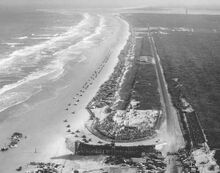
Daytona Beach during the 1930s.
On March 8, 1936, a collection of drivers gathered at Daytona Beach, Florida. The drivers brought coupes, hardtops, convertibles, and sports cars to compete in an event to determine the fastest cars, and best drivers. Throughout the race, the heavier cars got bogged down in the sand, while the lightweight Fords navigated the ruts of the course, eventually claiming the top 6 finishes for the race. Of the 27 cars that started the event, only 10 managed to survive the ordeal, as officials halted the event 10 miles short of the scheduled 250-mile distance. Driver Milt Marion was declared the winner, and a young Bill France placed 5th at the end of the day.
By early 1947, Bill France saw the potential for a unified series of racing competitors. France announced the foundation of the "National Championship Stock Car Circuit", otherwise known as NCSCC. France approached the American Automobile Association, or AAA, in hopes of obtaining financial backing for the venture. When the AAA declined support of the venture, France proceeded to announce a set of rules and awards for the NCSCC. France declared that the winner of the 1947 NCSCC season would receive $1000.00, and a trophy. The season would begin in January 1947 at the Daytona Beach track, and conclude in Jacksonville the following December. Nearly 40 events were logged during the season, and attendance often exceeded the venue's capacity. The competitors were paid as promised, and by the end of the season, driver Fonty Flock was declared the season champion after winning 7 events of the 24 that he entered. Bill France delivered the $1000 and 4-foot high trophy to Flock at the end of the season, along with $3000 in prize money to other drivers who competed throughout the season.
At the end of the 1947 season, Bill France announced that there would be a series of meetings held at the Streamline Hotel in Florida, beginning on December 14, 1947. At 1:00 pm, France called to order the 35 men who represented the NCSCC on the top floor of the hotel. The meeting was the first of four seminars in which France would outline his vision of an organized group of race car drivers. The name originally chosen for the series was National Stock Car Racing Association; when it was pointed out that that name was already in use by a rival sanctioning body, "National Association for Stock Car Auto Racing", proposed by mechanic Red Vogt, was selected as the organization's name.

Daytona Beach in the mid '50s.
NASCAR was founded by William France, Sr., on February 21, 1948 with the help of several other drivers of the time. The points system was written on a bar room napkin. The original plans for NASCAR included three distinct divisions: Modified, Roadster, and Strictly Stock. The Modified and Roadster classes were seen as more attractive to fans. It turned out that NASCAR fans wanted nothing to do with the roadsters, which fans perceived as a Northeast or Midwest series. The roadster division was quickly abandoned, while the modified division now operates as the Whelen Modified Tour. The Strictly Stock division was put on hold as American automobile manufacturers were unable to produce family sedans quickly enough to keep up with post-World War II demand. The 1948 schedule featured 52 Modified dirt track races. The sanctioning body hosted its first event at Daytona Beach on February 15, 1948. Red Byron beat Marshall Teague in the Modified division race. Byron won the 1948 national championship. Things had changed dramatically by 1949, and the Strictly Stock division was able to debut with a 20-mile (32 km) exhibition in February near Miami.
The first NASCAR "Strictly Stock" race ever was held at Charlotte Speedway, although this is not the same track as the Charlotte Motor Speedway that is a fixture on current NASCAR schedule. The race was held on June 19, 1949 and won by driver Jim Roper when Glenn Dunaway was disqualified after the discovery of his altered rear springs. Initially, the cars were known as the "Strictly Stock Division" and raced with virtually no modifications on the factory models. This division was renamed the "Grand National" division beginning in the 1950 season. Over a period of more than a decade, modifications for both safety and performance were allowed, and by the mid-1960s, the vehicles were purpose-built race cars with a stock-appearing body.
Early in NASCAR's history, foreign manufacturers had shown interest in entering the series; the British car manufacturer, MG, found a few of its vehicles entered, with some placing. For example, in August 16, 1963 in the International 200, Smokey Cook drove an MG to a 17th-place finish.
The first NASCAR competition held outside of the U.S. was in Canada, where on July 1, 1952, Buddy Shuman won a 200-lap race on a half-mile (800 m) dirt track in Stamford Park, Ontario, near Niagara Falls.
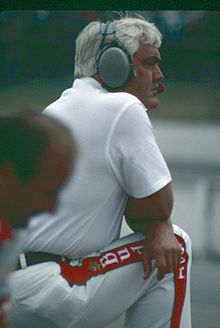
Junior Johnson, seen here in 1985, was a popular NASCAR driver from the 1950s who began as a bootlegging driver from Wilkes County, North Carolina.
Monster Energy Series[]
The Monster Energy NASCAR Cup Series is the sport's highest level of professional competition. It is consequently the most popular and most profitable NASCAR series. Since 2001, the Cup Series season has consisted of 36 races over 10 months. Writers and fans often use "Cup" to refer to the Monster Energy NASCAR Cup Series and the ambiguous use of "NASCAR" as a synonym for the series is common. The 2016 Sprint Cup Series Champion is Jimmie Johnson. Johnson won five consecutive Cup Series drivers' championships from 2006 to 2010. Previously, the most consecutive championships had been three in a row by Cale Yarborough in the late 1970s, the only other time when a driver has won three or more NASCAR Cup Series championships in a row.
The Cup Series had its first title sponsor in 1972. R. J. Reynolds Tobacco Company, which had been banned from television advertising, found a popular and demographically suitable consumer base in NASCAR fans and engaged NASCAR as a promotional outlet. As a result of that sponsorship, the Grand National Series became known as the Winston Cup Series starting in 1971, with a new points system and some significant cash benefits to compete for championship points. In 1972, the season was shortened from 48 races (including two on dirt tracks) to 31. 1972 is often acknowledged as the beginning of NASCAR's "modern era". The next competitive level, called Late Model Sportsman, gained the "Grand National" title passed down from the top division and soon found a sponsor in Busch Beer.

Dale Jr. after his 2004 Daytona 500 victory. Dale Sr. had to leave before this picture to attend to family matters.
In 2004, Nextel Communications took over sponsorship of the premier series from R. J. Reynolds, who had sponsored it as the Winston Cup from 1972 until 2003, and formally renamed it the Nextel Cup Series. A new championship points system, the "Chase for the Sprint Cup," was also developed, which reset the point standings with ten races to go, making only drivers in the top ten or within 400 points of the leader eligible to win the championship. This was quickly scrapped however at the behest and outrage of series veteran Dale Earnhardt Sr., other older drivers and many veteran NASCAR fans.
In 2007, NASCAR announced it was reintroducing "The Chase" concept, and changing the original ten drivers to twelve drivers, eliminating the 400-point cutoff, and giving a ten-point bonus to the top twelve drivers for each of the races they have won out of the first 26. Wins throughout the season would also be awarded five more points than in previous seasons. In 2008, the premier series title name became the Sprint Cup Series, as part of the merger between Nextel and Sprint. NASCAR also held an exhibition race at Montreal in Quebec, Canada, becoming that year's host to the NASCAR NEXTEL All-Star Challenge, set for May 19, with Lowe's Motor Speedway regaining the event the next year.
In 2011, NASCAR announced a number of major rules changes. The most important was a simplified points system that is also being adopted by the Nationwide and Truck Series. The winner of a race now receives 43 points, with one-point decrements for each subsequent position (42 for second, 41 for third, and so on). The winner also receives 3 bonus points, and single bonus points are awarded to all drivers who lead a lap, plus the driver who leads the most laps. Another significant change involves the qualifying process for the Chase. The number of qualifying drivers will remain at 12, but only the top 10 will qualify solely on regular-season points. The remaining two Chase drivers will be the two drivers in the next 10 of the point standings (11th through 20th) with the most race wins in the regular season.

Start of the 2015 Daytona 500.
In 2014, NASCAR announced another revamp to the Chase format, expanding the Chase pool to 16 drivers, and eliminating four drivers after every three races, leaving four drivers to compete for the championship at the season finale at Homestead. In addition, wins were given an increased emphasis, with the 16 drivers with the most wins (15 if the points leader is winless; points leader will receive an automatic berth) gaining a spot in the chase. If there are less than 16 winners, the remaining spots will be filled based on the conventional points system. Monster Energy became the title sponsor in 2017, which changed the series' name to Monster Energy NASCAR Cup Series. The changes made throughout the 2010s were expected to stay but under a full-out Sprint Cup protest of DEI, Petty Enterprises and other teams in 2015 and through some of 2016 the plans were scrapped for 2017 along with the COT.
Xfinity Series[]
The NASCAR Xfinity Series is the second-highest level of professional competition in NASCAR. The most recent series champion is Daniel Suárez in 2016.
The modern incarnation of this series began in 1982, with sponsorship by Anheuser-Busch Brewing's Budweiser brand. In 1984 it was renamed to the Busch Grand National Series, then later just the Busch Series. The Anheuser-Busch sponsorship expired at the end of 2007, being replaced by Nationwide Insurance from 2008-2014, and the series is now sponsored by Comcast through its Xfinity brand.
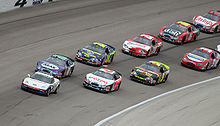
Nationwide Series at Texas, 2007.
The season is usually a few races shorter than that of the Monster Energy NASCAR Cup Series, and the prize money is significantly lower. However, over the last several years, a number of Cup Series drivers have run both the Xfinity and Cup Series events each weekend, using the Xfinity race as a warm-up to the Cup event at the same facility. Furthermore, several drivers not only participated in both Cup and Busch/Nationwide events in the same weekend but also began to compete in both series on a full-time basis. Kevin Harvick was the first Cup series driver to compete full-time in the Busch Series and win a title, actually doing so twice; in 2003, he did this for Richard Childress Racing but only did so out of necessity as Dale Earnhardt's retirement forced him into the Cup series. His win in 2006, where he raced three separate cars for RCR and his own race team, was the first of five consecutive titles in NBS/NNS that were won by Cup series regulars.
The practice received criticism because it was thought to give the Monster Energy NASCAR Cup Series teams an unfair advantage, and that the presence of the Cup Series drivers squeezes out Nationwide Series competitors who would otherwise be able to qualify. These dual-series drivers have been labeled "Buschwhackers", a play on words which combines the original series sponsor's name with the notion of being bushwhacked. In May 2007, NNS director Joe Balash confirmed that NASCAR was exploring options to deal with the Buschwhacker controversy. One of the most often-cited proposals was for Cup Series drivers participating in the Nationwide Series to receive no points for their participation in a Nationwide race. In 2007, NASCAR chairman Brian France indicated that all options, except an outright ban of Cup competitors, were still being considered.

Nationwide Series at Road America in 2011.
On January 11, 2011, NASCAR.com reported that beginning with the 2011 season, drivers would be allowed to compete for the championship in only one of NASCAR's three national series in a given season, although they could continue to run in multiple series. This change was officially confirmed by France in a press conference less than two weeks later, and remained in the NASCAR rules until 2017, when Cup drivers were permanently banned from racing in this series. Beginning in 2010, the Nationwide cars adapted somewhat to the current "Car of Tomorrow" (or COT) design used by Cup cars, with different bodies from the Cup Series. In 2015, the Chase format was supposed to be extended to Nationwide and Craftsmen Truck Series, but under a full-out Sprint Cup protest of DEI, Petty Enterprises and others the plans were scrapped,.
Craftsmen Truck Series[]
The NASCAR Camping World Truck Series features modified pickup trucks. It is one of the three national divisions of NASCAR, together with the Xfinity Series and the Monster Energy NASCAR Cup Series. The most recent series champion is Johnny Sauter in 2016; it was Sauter's first championship in the series.
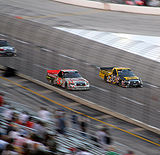
Mike Skinner racing Todd Bodine in the Texas Craftsman Truck Series race.
In 1994, NASCAR announced the formation of the NASCAR SuperTruck Series presented by Craftsman. The first series race followed in 1995. In 1996, the series was renamed the NASCAR Craftsman Truck Series to emphasize Craftsman's involvement. The series was first considered something of an oddity or a "senior tour" for NASCAR drivers, but eventually grew in popularity and has seen drivers move straight to the Cup Series without running a full season in Xfinity Series competition. These include Kurt Busch and Carl Edwards (who both ran for Roush Racing). In addition, veteran drivers who have had only moderate success at the other two levels of the sport have revitalized their careers in the truck series, including Ron Hornaday Jr., Todd Bodine, Mike Skinner, and Johnny Benson. Beginning in 2009, the series became the Camping World Truck Series. As noted previously, the Chase format was supposed to be extended to the Truck Series in 2015, but wasn't due to protest.
PEAK Mexico Series[]
In December 2006, NASCAR also announced the creation of a new series in Mexico, the NASCAR Corona Series (now PEAK Mexico Series), replacing the existing Desafío CoronaSeries, to begin in 2007.
European Modified Series[]
In early 2012, NASCAR announced that it would sanction the existing European-based Racecar Euro Series as a "NASCAR Touring Series". On July 1, 2013, with partnership from Whelen Engineering, the series was renamed the NASCAR Whelen Euro Series.
Regional racing series[]
In addition to the six main national series, NASCAR operates several other racing divisions.
Whelen All-American Series[]
Many local race tracks across the United States and Canada run under the Whelen All-American Series banner, where local drivers are compared against each other in a formula where the best local track champion of the nation wins the Whelen All-American Weekly Series National Championship. The Whelen All-American series is split into four car divisions as well as state and track championships separately. Each division champion receives a point-fund money payout and even more goes to the National champion (driver with most points out of the four division winners). The Whelen All-American Series is the base for stock car racing, developing NASCAR names such as Clint Bowyer, Jimmy Spencer, Tony Stewart, the Bodine brothers, and many others along the way.
Whelen Modified Tour[]
The Whelen Modified Tour races open-wheel "modified" cars in Northern and Southern divisions. This is NASCAR's oldest division, and the modern division has been operating since 1985 as the Winston Modified Series and later in 1994 as the Featherlite Trailers Modified Series.
K&N Pro Series[]
The K&N Pro Series, which consists of East and West divisions, race pro-stock cars that are similar to older Nationwide Series cars, although they are less powerful. The east division was originally divided into the Busch North series, which raced in Northeastern states, and the Busch East Series, which raced throughout Southeastern and Mid-Atlantic states. The west division was originally known as the Winston West Series and raced throughout Southwestern and Coastal Pacific states. In 2008, the series came together in east and west divisions under sponsorship from Camping World as the Camping World Series. K&N Filters took over the sponsorship in 2010.
NASCAR iRacing.com Series[]
In 2010, NASCAR officially sanctioned its first sim racing series, partnering with iRacing.com to form the NASCAR iRacing.com Series. This sim racing series is made of up of five "Amateur Series" divisions, the NASCAR iRacing.com Pro Series, and the NASCAR iRacing.com World Championship Series. Each year, the champion of the NASCAR iRacing.com World Championship Series is invited to NASCAR's Championship Weekend at Homestead-Miami Speedway to receive their prize money and championship at the track.
Driver Safety[]
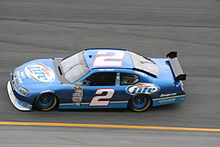
The COT premiered at Bristol in 2007, and ran until the end of the 2016 season.
Although NASCAR frequently publicizes the safety measures it mandates for drivers, these features are often only adopted long after they were initially developed, and only in response to an injury or fatality. The impact-absorbing "SAFER Barrier" that is now in use had been proposed by legendary mechanic Smokey Yunick during the 1970s, but his idea had been dismissed as too expensive and unnecessary. Only after the deaths of Adam Petty, Kenny Irwin and Tony Roper in 2000, combined with Dale Earnhardt's scary crash in 2001 did NASCAR revisit the idea of decreasing the G-forces a driver sustained during a crash. Other examples of available safety features that were slow to be implemented include the mandating of a throttle "kill switch". The "kill switch" was mandated after the death of Adam Petty, along with the requirements of an anti-spill bladder in fuel cells. Fire-retardant driver suits were required only after the death of Glen "Fireball" Roberts, who died from complications of burns suffered in a crash when flames engulfed his car during a Charlotte race. Likewise only Adam Petty's death prompted NASCAR to require all drivers to use the "HANS device" (Head And Neck Support Device), a device that keeps the driver's neck from going forward in a wreck. In the mid-2000s, NASCAR redesigned the racing vehicle with safety improvements, calling it the Car of Tomorrow. The car has a higher roof, wider cockpit, and the driver seat was located more toward the center of the vehicle, but many old racers like Dale Earnhardt despised it, and for 2017 the car was scrapped and NASCAR went back to their previous car setup from the early 2000s.
Criticism[]
Similar to other professional leagues and sanctioning bodies, NASCAR has been the target of criticism on various topics from various sources. Some critics note the significant differences between today's NASCAR vehicles and true "stock" cars. Others frequently cite the dominance of the France family in NASCAR's business structure, policies, and decision making. Recently, the increased number of Cup drivers competing consistently in the Xfinity Series races has been hotly debated. Another general area of criticism, not only of NASCAR but other motorsports as well, includes questions about fuel consumption, emissions and pollution, and the use of lead additives in the gasoline. Originally scheduled for 2008, NASCAR adopted the use of unleaded fuel in all three of its top series in 2007. In 2011, NASCAR switched to E15 "green" fuel (15% ethanol and 85% gasoline) for all three touring series. As NASCAR has made moves to improve its national appeal, it has begun racing at new tracks, and ceased racing at some traditional ones – a sore spot for the traditional fan base. Most recently, NASCAR has been challenged on the types and frequency of caution flags, with some critics suggesting the outcome of races is being manipulated, and that the intention is not safety, as NASCAR claims, but closer racing. There have been a few accidents involving fans during races and even some off the tracks, but no spectator has ever been killed during a race in an accident relating to the race, although a fan was killed by a lightning strike in 2012 after the 2012 Pennsylvania 400 at Pocono was called short due to the storm. It was revealed in 2008 that a wrongful death lawsuit against NASCAR stemming from the crash of a company plane was settled for $2.4 million. In 2015 mass protests and pull-outs made by teams the like of DEI and Petty Enterprises led to NASCAR reverting many of these race-related criticisms.
